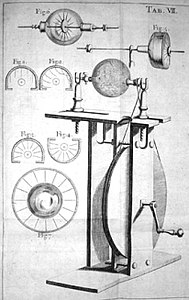
Francis Hauksbee
Author
1666 – 1713
Who was Francis Hauksbee?
Francis Hauksbee the elder, also known as Francis Hawksbee, was an 18th-century English scientist best known for his work on electricity and electrostatic repulsion.
The son of draper Richard Hauksbee, he was baptized on 27 May 1660 in Colchester.
Initially apprenticed in 1678 to his elder brother as a draper, Hauksbee became Isaac Newton’s lab assistant. In 1703 he was appointed curator, instrument maker and experimentalist of the Royal Society by Newton, who had recently become president of the society and wished to resurrect the Royal Society’s weekly demonstrations.
Until 1705, most of these experiments were air pump experiments of a mundane nature, but Hauksbee then turned to investigating the luminosity of mercury which was known to emit a glow under barometric vacuum conditions.
By 1705, Hauksbee had discovered that if he placed a small amount of mercury in the glass of his modified version of Otto von Guericke's generator, evacuated the air from it to create a mild vacuum and rubbed the ball in order to build up a charge, a glow was visible if he placed his hand on the outside of the ball. This glow was bright enough to read by. It seemed to be similar to St. Elmo's Fire. This effect later became the basis of the gas-discharge lamp, which led to neon lighting and mercury vapor lamps. In 1706 he produced an 'Influence machine' to generate this effect. He was elected a Fellow of the Royal Society the same year.
We need you!
Help us build the largest biographies collection on the web!
Citation
Use the citation below to add to a bibliography:
Style:MLAChicagoAPA
"Francis Hauksbee." Biographies.net. STANDS4 LLC, 2024. Web. 28 Apr. 2024. <https://www.biographies.net/people/en/francis_hauksbee>.

Discuss this Francis Hauksbee biography with the community:
Report Comment
We're doing our best to make sure our content is useful, accurate and safe.
If by any chance you spot an inappropriate comment while navigating through our website please use this form to let us know, and we'll take care of it shortly.
Attachment
You need to be logged in to favorite.
Log In